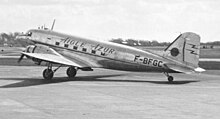Turbomeca Palas
| Palas | |
|---|---|

| |
| Sectioned Turbomeca Palas | |
| Type | Turbojet |
| National origin | France |
| Manufacturer | Turbomeca |
| Major applications | Miles Sparrowjet Short SB.4 Sherpa |
| Developed from | Turbomeca Piméné |
The Turbomeca Palas is a diminutive centrifugal flow turbojet engine used to power light aircraft. An enlargement of the Turbomeca Piméné, the Palas was designed in 1950 by the French manufacturer Société Turbomeca,[1] and was also produced under licence by Blackburn and General Aircraft in the United Kingdom and Teledyne Continental Motors in the United States as the Continental Model 320.
Applications

- Caproni Trento F.5
- Curtiss C-46 Commando (two under the fuselage, first flight in October 1952)
- Curtiss C-46F Commando (two under the wings)
- CVV-6 Canguro Palas
- Douglas DC-3 (as a booster engine)
- Fouga CM-8 R9.8 Cyclope
- Fouga CM-8 R8.3 Midget
- Fouga CM.130
- Ikarus 451
- Ikarus S451M
- Ikarus 452M
- Mantelli AM-12
- Miles Sparrowjet
- Payen Pa 49
- Short SB.4 Sherpa
- SIPA S.200 Minijet
- SIPA S.300
- Somers-Kendall SK-1
- Sud-Ouest Bretagne
Specifications
Data from Aircraft engines of the World 1953 [2]
General characteristics
- Type: Turbojet
- Length: 1,200 mm (47 in)
- Diameter: 408 mm (16.1 in)
- Dry weight: 72 kg (159 lb)
Components
- Compressor: single-stage centrifugal
- Combustors: annular with rotary fuel injection
- Turbine: single-stage with 24 or 25 blades
- Fuel type: Jet A1
- Oil system: dry sump with Turbomeca gear pump at 3.0 bar (43 psi)
Performance
- Maximum thrust:
- Take-off: 1.6 kN (350 lbf)
- Max Continuous: 1.27 kN (285 lbf)
- Cruising: 0.98 kN (220 lbf)
- Overall pressure ratio: 4:1
- Air mass flow: 3.1 kg/s (6.8 lb/s)
- Turbine inlet temperature:
- TIT: 1,123.15 K (850 °C)
- JPT: 973.15 K (700 °C)
- Specific fuel consumption: 110 kg/kN/h (1.1 lb/lbf/h)
- Thrust-to-weight ratio: 2.20 (take off), 1.79 (max continuous), 1.38 (cruising).
See also
Related lists
References
- Notes
- Bibliography
- Gunston, Bill. World Encyclopedia of Aero Engines. Cambridge, England. Patrick Stephens Limited, 1989. ISBN 1-85260-163-9
External links
- Palas at Minijets.org Archived 2007-10-07 at the Wayback Machine
